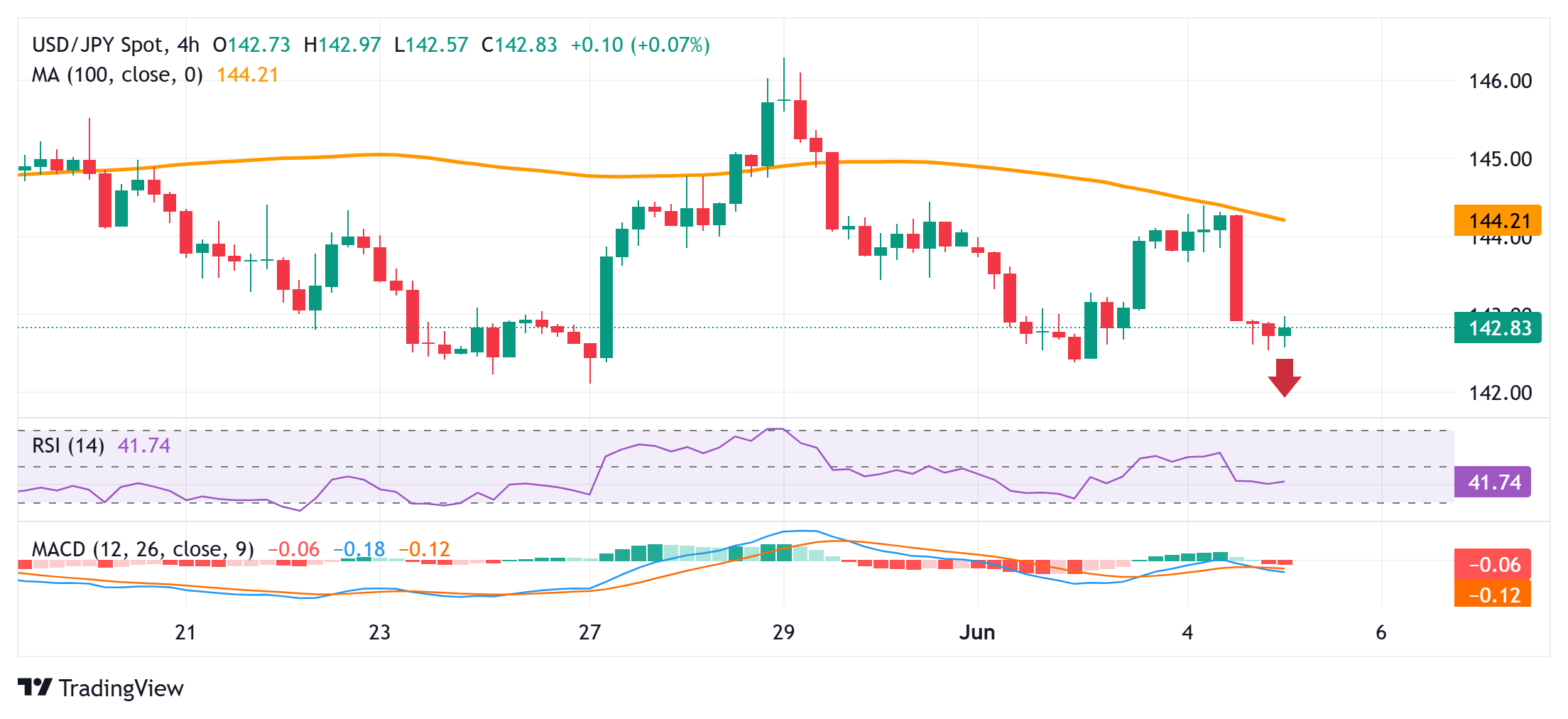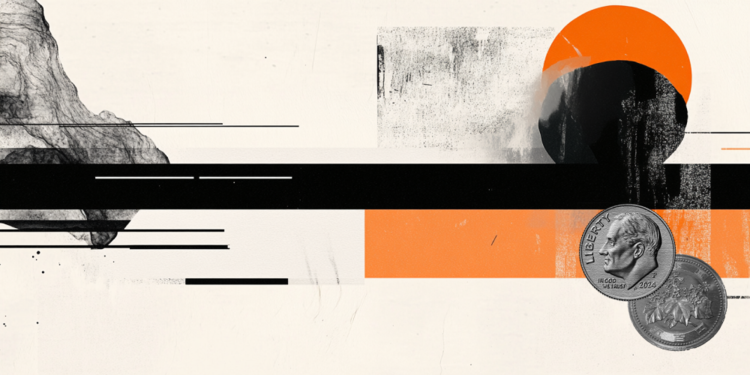- The Japanese Yen turns lower against the USD, though the downside seems limited.
- Bets that the BoJ will hike rates again and safe-haven buying could underpin the JPY.
- Dovish Fed expectations might cap any meaningful upside for the USD and USD/JPY.
The Japanese Yen (JPY) edges lower against a recovering US Dollar (USD) during the Asian session on Thursday and stalls the previous day’s goodish rebound from the weekly low. Any meaningful JPY depreciation, however, seems elusive amid the growing acceptance that the Bank of Japan (BoJ) will continue raising interest rates. The expectations were reaffirmed by data showing that Japan’s real wages fell for the fourth consecutive month in April amid stubborn inflation.
Apart from this, the cautious market mood ahead of potential talks between US President Donald Trump and Chinese President Xi Jinping, along with trade uncertainties and geopolitical risks, could underpin the safe-haven JPY. Meanwhile, Wednesday’s weaker US data lifted bets that the Federal Reserve (Fed) will lower borrowing costs further in 2025. This should cap the upside for the USD and limit losses for the lower-yielding JPY, which, in turn, keeps a lid on the USD/JPY pair.
Japanese Yen bulls seem reluctant despite rising BoJ rate hike bets
- Government data released earlier this Thursday showed that nominal wages increased 2.3% from a year earlier in April, or the fastest pace in four months and up for the 40th consecutive month. However, real wages slumped 1.8% as rising prices continued to outpace pay hikes.
- The consumer inflation rate that is used to calculate real wages eased slightly to the 4.1% YoY rate during the reported month compared to 4.2% in March, though it stayed above 4% for the fifth month in a row. This backs the case for further rate hikes by the Bank of Japan (BoJ).
- In contrast, traders lifted bets that the Federal Reserve could cut interest rates as soon as September in reaction to Wednesday’s weaker-than-expected US macro data. In fact, Automatic Data Processing (ADP) reported that private sector employment in the US rose 37K in May.
- This was the lowest monthly job count since March 2023 and was accompanied by a downward revision of April’s reading to 60K. Adding to this, the survey from the Institute for Supply Management (ISM) showed the US services sector contracted for the first time since June 2024.
- US President Donald Trump continues to press Fed Chair Jerome Powell to lower interest rates. Moreover, the yields on the rate-sensitive two-year and the benchmark 10-year US government bonds fell to the lowest level since May 9, which weighed heavily on the US Dollar.
- The lack of follow-through USD selling, however, assists the USD/JPY pair in attracting some buyers during the Asian session on Thursday. Nevertheless, the divergent BoJ-Fed policy expectations might hold back traders from placing aggressive bullish bets around the currency pair.
- Traders keenly await the high-stakes call between Trump and Chinese President Xi Jinping amid renewed trade tensions. It, however, remains unclear if such a call had been arranged. In the meantime, Trump said that it was extremely hard to make a deal with the Chinese leader.
- This keeps the risk premium associated with a trade war between the world’s two largest economies in play. This, along with rising geopolitical tensions, should contribute to limiting losses for the safe-haven JPY and keep a lid on any meaningful upside for the USD/JPY pair.
- Traders now look forward to the release of the usual Weekly Initial Jobless Claims data from the US. Apart from this, speeches from influential FOMC members could provide some impetus in the run-up to the highly-anticipated US Nonfarm Payrolls (NFP) report on Friday.
USD/JPY remains vulnerable while below the 100-period SMA on H4

From a technical perspective, the overnight failure near the 100-period Simple Moving Average (SMA) on the 4-hour chart and the subsequent fall favors the USD/JPY bears. Moreover, technical indicators on hourly/daily charts are holding in negative territory, suggesting that the path of least resistance for spot prices is to the downside. Hence, any further move up could be seen as a selling opportunity near the 143.70 region and is likely to remain capped near the 144.00 mark. This is followed by the 144.25-144.30 region (100-period SMA on H4). Some follow-through buying beyond the overnight swing high could trigger an intraday short-covering move and allow bulls to reclaim the 145.00 psychological mark.
On the flip side, the weekly trough, around the 142.40-142.35 area, could offer some support to the USD/JPY pair ahead of the 142.10 region, or last week’s swing low. A convincing break below the latter could make spot prices vulnerable to resume the recent downward trajectory from the May swing high and slide further to the next relevant support near the 141.60 area en route to sub-141.00 levels.
Bank of Japan FAQs
The Bank of Japan (BoJ) is the Japanese central bank, which sets monetary policy in the country. Its mandate is to issue banknotes and carry out currency and monetary control to ensure price stability, which means an inflation target of around 2%.
The Bank of Japan embarked in an ultra-loose monetary policy in 2013 in order to stimulate the economy and fuel inflation amid a low-inflationary environment. The bank’s policy is based on Quantitative and Qualitative Easing (QQE), or printing notes to buy assets such as government or corporate bonds to provide liquidity. In 2016, the bank doubled down on its strategy and further loosened policy by first introducing negative interest rates and then directly controlling the yield of its 10-year government bonds. In March 2024, the BoJ lifted interest rates, effectively retreating from the ultra-loose monetary policy stance.
The Bank’s massive stimulus caused the Yen to depreciate against its main currency peers. This process exacerbated in 2022 and 2023 due to an increasing policy divergence between the Bank of Japan and other main central banks, which opted to increase interest rates sharply to fight decades-high levels of inflation. The BoJ’s policy led to a widening differential with other currencies, dragging down the value of the Yen. This trend partly reversed in 2024, when the BoJ decided to abandon its ultra-loose policy stance.
A weaker Yen and the spike in global energy prices led to an increase in Japanese inflation, which exceeded the BoJ’s 2% target. The prospect of rising salaries in the country – a key element fuelling inflation – also contributed to the move.

